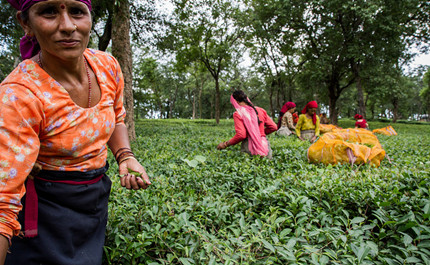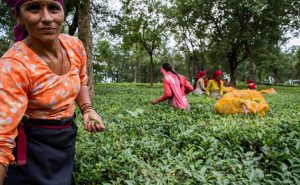Less than normal monsoon rains forecast this year are likely to reduce crop yields and affect agriculture-based economies of South Asia

The year’s most critical weather prognosis is in. The anxiously awaited June to September monsoon is likely to be less than normal in large swathes of South Asia, affecting agricultural output on which rests the economies of several nations.
The South Asian Climate Outlook Forum (SASCOF), which met in the Indian city of Pune in April, said in its summary statement that “below normal rainfall” was likely over broad areas of western central and southwestern parts of South Asia as well the northeastern parts of the region. “There is strong consensus among the experts about the possibility of evolution of an El Nino effect during the summer monsoon season,” said the Forum, hosted by the India Meteorological Department (IMD) and attended by experts from across the world as well as those from the eight South Asian countries – India, Nepal, Bangladesh, Pakistan, Maldives, Bhutan, Sri Lanka and Afghanistan. The possibility of less rain was backed by others, including Bangladesh’s meteorological department and private weather forecasting agency Skymet.
As weather departments fine-tuned their calculations on the phenomenon that brings in rain to the region, experts began analysing the possible impact of the forecast and said there was no reason to panic.
“We are not in a stage of panic. There is a hope that it will go. It is not a drought year… There could still be more than normal rainfall in certain pockets but people should definitely not panic as this could lead to the hoarding of food grains,” D.S. Pai, head of IMD’s Long Range Forecast division, told thethirpole.net. According to the IMD, the northwest and central parts of the country are likely to experience a weak monsoon.
Impact on India
In India, the largest country in the region, the monsoon is of pivotal importance. With most of India’s one billion plus people living in rural areas, agriculture accounts for an estimated 14% of Asia’s third largest economy. The monsoon accounts for almost 80% of the rainfall in India and, with 65% of agriculture being rain fed, the criticality of a good, timely monsoon cannot be overstated.
The kharif crop – including paddy, millet, pulses and sunflower – is sown as the rains begin and the monsoon progresses through India. It is harvested during autumn.
Accurate forecasts play an important role in this scenario. “Our models give a large scale picture. We can’t predict the scale of impact as rain requirements, temperature requirements are different for different stages of the life cycle of crops. But this will help the government to make export decisions — what kind of crops should be grown this year and how to make drought-resistant seeds available to farmers,” said Pai.
How accurate are monsoon forecasts?
Food and trade policy analyst Devinder Sharma is worried.” The IMD forecast shows that there will be below normal rainfall this monsoon though it doesn’t talk about drought. But the thing is that IMD has never predicted drought before. Not even in 2009.” That’s the year India faced its last major drought. At the time, the met department had predicted 96 % of the average rainfall (similar to this year) but the actual deficit turned out to be a high 23% making it one of the worst drought years in recent times.
Skymet, he says, has predicted a 25% chance of drought this year. In 2012, Skymet predicted 94% rainfall and the actual rainfall turned to be almost the same – 93%. Similarly, in 2013, it predicted a little higher rainfall of 103% just a little less than the actual 106%.
Though there was no need to panic, steps need to be taken to prepare for the worst, Sharma says. Marginal farmers will bear the brunt. “We don’t even have any crop insurance scheme in the country despite suggesting repeatedly to the government. Whatever schemes are there, they are just at the pilot stage.”
“First of all, focus should be on less water intensive agricultural practices like SRI (system of rice intensification) method that cuts down the water consumption by 30- 40%. This is huge as growing just one kilogramme of rice consumes 3,000-3,500 kilogrammes of water.” Sharma added.
Taking the discussion further, S. Sivakumar, chairperson of the National Council on Agriculture at the business lobby Confederation of Indian Industry (CII), said: “We can’t start speculating too much based on the 60% probability of El Niño forecasted by IMD. If it is the usual drought associated with the El Niño, we can be confident of India’s resilience, as has been demonstrated in the recent past; but if it is more rains early on and no rains in the later part of the monsoon period, as indicated by the Pune Regional Climate Centre a few weeks ago, it is more difficult to design appropriate contingency plans.”
Concerns echo around the region
“We are not able to say more at the moment. But it seems there would not be much rainfall in this season,” said Md Shah Alam, director of the Bangladesh Meteorological Department.
The country gets most of its rainfall in the four months between May to September. But the pattern is already evident. In March 2014, there was 66% less rain. In April, it will be 50 % less rainfall than usual, officials say. On April 24, the mercury touched 40.7 degrees Celsius, a 54-year high for the month.
In Pakistan, Pervaiz Amir former member of the Pakistan Prime Minister’s Task Force on Climate Change and head of Pakistan Water Partnership, believes that if the forecasts are correct then his country is in for difficult times.
If the southern half of the country – major sowing area for vegetables as well as cotton, rice and sugarcane – gets below normal rains then “productivity of the cereal crops of summer season in both rain-fed and irrigated areas will receive a severe blow”.
“It will render Pakistan unable to achieve production targets for summer crops,” Amir, who studied agronomy at the Michigan University in the US, added.
According to him, high temperatures and dry conditions in May and June mean that evaporation of water in the country’s irrigation network and farmlands is very high, especially in the southern parts of the country. The monsoon rain plays a crucial role in reducing evaporation and meeting the water requirement of crops in the rain-fed areas of the country, particularly in the northern parts.
Taking a somewhat different view, Arif Mahmood, director general of the Pakistan Meteorological Department (PMD), played down the reliability of the SACOF forecast.
“The Forum has issued four monsoonal forecasts since 2010, which have gone squarely wrong. However, we cannot give weight to the fifth forecast about monsoon rainfall,” he told thethirdpole.net.
“After taking stock of the weather in May, the PMD issues its own forecast during the first week of June about summer monsoon rains that sets off in the country in June and continues until September-end,” the PMD director general said.
In Pakistan, summer crops are sown between May-July and in some areas in northern parts as late as mid-July.
“Glacial-melt water in the Indus river basin is more vital than the monsoon rains. The rains only complement the river flows,” he said.
